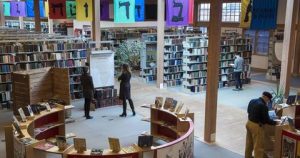From the Yiddish Book Center
The Yiddish Book Center Weekly Reader
From Lorna Holmes
May 2022
Detroit Gefilte City
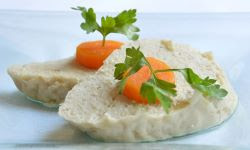 Each year, the Hermelin family of Detroit comes together to celebrate Passover, and central to their seder meal is the family’s homemade gefilte fish. Now that recipe is the subject of writer and director Rachel Fleit’s latest film, Gefilte. As Fleit notes, “While simple on the surface, Gefilte is filled with history and meaning—just like the recipe itself, which includes a stuffing of fish, salt, vegetables, and egg.” Listen to an interview with Rachel Fleit: https://www.yiddishbookcenter.org/language-literature-culture/the-shmooze/181-gefilte-story-one-family-s-holiday-tradition
Each year, the Hermelin family of Detroit comes together to celebrate Passover, and central to their seder meal is the family’s homemade gefilte fish. Now that recipe is the subject of writer and director Rachel Fleit’s latest film, Gefilte. As Fleit notes, “While simple on the surface, Gefilte is filled with history and meaning—just like the recipe itself, which includes a stuffing of fish, salt, vegetables, and egg.” Listen to an interview with Rachel Fleit: https://www.yiddishbookcenter.org/language-literature-culture/the-shmooze/181-gefilte-story-one-family-s-holiday-tradition
April 2022
A Conference in Chernovits Ukraine
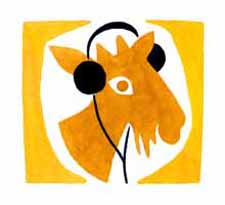 In 1908 Jewish intellectuals from across Europe gathered in the city of Chernovits—or Chernovitsi, in Ukrainian—to determine the future of the Yiddish language.
In 1908 Jewish intellectuals from across Europe gathered in the city of Chernovits—or Chernovitsi, in Ukrainian—to determine the future of the Yiddish language.
Although the stated purpose of the First Yiddish Language Conference was to elevate and standardize the language, thus furthering its literary and cultural ambitions, the gathering nearly got derailed by a fierce dispute about the status of Yiddish relative to Hebrew.
Was Yiddish “a” Jewish national language or “the” Jewish national language? In the end, the indefinite article won out. I.L. Peretz reports from the conference, with commentary and background provided by Catherine Madsen.
Read more at: https://www.yiddishbookcenter.org/language-literature-culture/pakn-treger/unruly-language-czernowitz-100.
Teaching Niggunim in the Fields of Ukraine
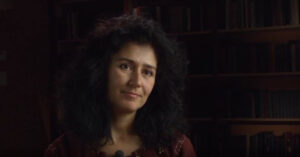 Polina Markovna Shepherd, Yiddish performer, composer, and choir leader, recalls her experience as a performer at a music festival in Ukraine. She describes the proud, Ukranian atmosphere of the events, and teaching nigunim in a field near the origins of nigunim themselves.
Polina Markovna Shepherd, Yiddish performer, composer, and choir leader, recalls her experience as a performer at a music festival in Ukraine. She describes the proud, Ukranian atmosphere of the events, and teaching nigunim in a field near the origins of nigunim themselves.
This is an excerpt from an oral history with Polina Markovna Shepherd. This excerpt is in English. Polina Markovna Shepherd was born in Tomsk, USSR.
Watch the video: https://www.yiddishbookcenter.org/collections/oral-histories/excerpts/woh-ex-0004743/teaching-nigunim-fields-ukraine-performances-ukrainian-music-festival
Under Seige
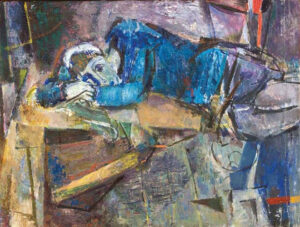 Painter, teacher, and stage designer Felix Samoilovich Lembersky was born in 1913 in Berdychiv and studied art in Kyiv, first at the Jewish Arts and Trades School and Kyiv Art Institute and then at the Leningrad Academy of Art, where he finished his thesis during the Siege of Leningrad.
Painter, teacher, and stage designer Felix Samoilovich Lembersky was born in 1913 in Berdychiv and studied art in Kyiv, first at the Jewish Arts and Trades School and Kyiv Art Institute and then at the Leningrad Academy of Art, where he finished his thesis during the Siege of Leningrad.
In this episode of The Shmooze podcast, Joel Berkowitz, director of the Sam and Helen Stahl Center for Jewish Studies at the University of Wisconsin-Milwaukee, describes how Lembersky resisted state-imposed strictures during the Soviet era to follow his own artistic inclinations—at great personal cost.
Listen to the podcast here: https://www.yiddishbookcenter.org/language-literature-culture/the-shmooze/90-felix-lembersky-soviet-form-jewish-context
On Stage
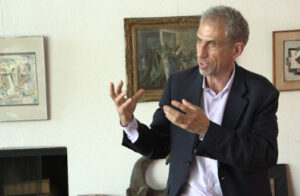 Boris Aronson was born in 1898 in Kyiv and immigrated to the United States in 1923, where he became a celebrated set designer for the Yiddish theater and Broadway, winning a Tony Award for scenic design six times. Some of his more noted productions include Fiddler on the Roof, Cabaret, Zorba, Company, Follies, and A Little Night Music.
Boris Aronson was born in 1898 in Kyiv and immigrated to the United States in 1923, where he became a celebrated set designer for the Yiddish theater and Broadway, winning a Tony Award for scenic design six times. Some of his more noted productions include Fiddler on the Roof, Cabaret, Zorba, Company, Follies, and A Little Night Music.
In this oral history interview his son, Marc Aronson, talks about his father’s involvement in the art world in Europe, including his participation in the Yiddish Kultur Lige in Kyiv, his work on a book about Chagall, and his involvement in the cabaret world in Berlin.
Watch an oral history interview: https://www.yiddishbookcenter.org/collections/oral-histories/excerpts/woh-ex-0004997/boris-aronson-s-involvement-art-and-kultur-lige-europe
March 2022
Glikl and her Sisters: The Creative Lives of 17th-Century Jewish Women— A new online course, March 8–29, 2022
 Held on Zoom, the class will meet on four consecutive Tuesdays:
Held on Zoom, the class will meet on four consecutive Tuesdays:
March 8, March 15, March 22, and March 29, 2022
7pm–8:15pm Eastern Time
(March 8 & 15 – 2pm-3:15pm HST, March 22 & 29 – 1pm-2:15pm HST)
At the end of the 1600s, businesswoman Glikl bas Yehude Leyb began writing what is considered to be the first autobiography of a Jewish woman. Over the next 28 years Glikl’s writing would describe, in minute detail, her work, her travels, her family, and the politics of the era. This document has become a unique point of access for readers interested in Jewish experience, life in the early modern period, and especially women’s perspectives. Women played a unique and important role in early modern European Jewish life, as businesswomen, wise women and halakhic authorities, and as composers of Yiddish-language prayers and liturgy.
This online course will explore the context and work of Glikl and a number of her contemporaries, such as Rivke bas Me’ir, first female author of a Yiddish book, and the midwives, widows, and daughters who collected books, wrote prayers, and contributed creativity and knowledge to the early modern Jewish world. Combining short lectures by renowned faculty, including Elisheva Carlebach, Chava Weissler, Joshua Teplitsky, and Jordan Katz, with lively small-group discussions of a variety of texts, the course will give students a rare glimpse into the creative lives of Jewish women, and of the ways that gender roles, Jewish law, and Christian society combined to both constrict and create opportunities for women’s quests for knowledge and expression.
For more information and to register: https://www.yiddishbookcenter.org/educational-programs/adult-learners/glikl-and-her-sisters-creative-lives-17th-century-jewish-women
Baym toyer (At the Gate)
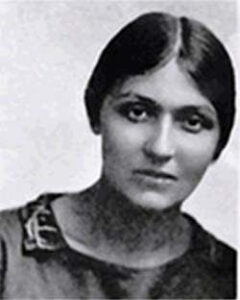 If you prefer (as I often do) to listen to your books, we’ve got 139 Yiddish audiobooks for you to choose from. That’s a lot of audiobooks, so if you’re looking for a place to start, you could do worse than listen to Baym toyer (At the Gate) by Kadya Molodowsky, about life in Israel after the Holocaust, read by Cecylia Serlin.
If you prefer (as I often do) to listen to your books, we’ve got 139 Yiddish audiobooks for you to choose from. That’s a lot of audiobooks, so if you’re looking for a place to start, you could do worse than listen to Baym toyer (At the Gate) by Kadya Molodowsky, about life in Israel after the Holocaust, read by Cecylia Serlin.
Listen to Baym Toyer: https://www.yiddishbookcenter.org/collections/audio-books/smr-kadia-molodowsky-baym-toyer
January 2022
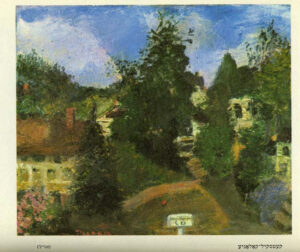 A Poet’s Paintings: Celia Dropkin (1887–1956) is a poet known for the boldness and honesty of her poetic imagery. Rather softer are the images Dropkin created with her paintbrush. In exploring our Dropkinalia, we came across a rare item: a collection of Dropkin’s little-known watercolor and oil paintings. The slim volume contains almost no bibliographic information, only Dropkin’s pictures, with titles in Yiddish and English. In the pictures, we see snow-dusted streets, vases of beautiful flowers, elegant ladies at rest, blue skies and green rolling hills. Manhattan’s windswept Riverside Park is there, and the vast Catskills, and palm-scented Florida. The Catskills scene appears to depict Dropkin’s own bungalow, as we can see in the mailbox with Dropkin’s initials, which forms a double signature with her own name printed in the adjacent corner. Read more: https://www.yiddishbookcenter.org/language-literature-culture/vault/celia-dropkins-paintings
A Poet’s Paintings: Celia Dropkin (1887–1956) is a poet known for the boldness and honesty of her poetic imagery. Rather softer are the images Dropkin created with her paintbrush. In exploring our Dropkinalia, we came across a rare item: a collection of Dropkin’s little-known watercolor and oil paintings. The slim volume contains almost no bibliographic information, only Dropkin’s pictures, with titles in Yiddish and English. In the pictures, we see snow-dusted streets, vases of beautiful flowers, elegant ladies at rest, blue skies and green rolling hills. Manhattan’s windswept Riverside Park is there, and the vast Catskills, and palm-scented Florida. The Catskills scene appears to depict Dropkin’s own bungalow, as we can see in the mailbox with Dropkin’s initials, which forms a double signature with her own name printed in the adjacent corner. Read more: https://www.yiddishbookcenter.org/language-literature-culture/vault/celia-dropkins-paintings
 On The Shmooze: Recommended Reads in Yiddish and English: From pocket-sized Yiddish books to on-my-night-table English-language works, The Shmooze’s producer Zeke Levine and host Lisa Newman sit down to discuss and recommend some of the titles from their recent reading lists—it’s an eclectic and surprising handpicked collection that will provide you with some great reads during the winter months. Listen: https://soundcloud.com/yiddishbookcenter/the-shmooze-ep0169
On The Shmooze: Recommended Reads in Yiddish and English: From pocket-sized Yiddish books to on-my-night-table English-language works, The Shmooze’s producer Zeke Levine and host Lisa Newman sit down to discuss and recommend some of the titles from their recent reading lists—it’s an eclectic and surprising handpicked collection that will provide you with some great reads during the winter months. Listen: https://soundcloud.com/yiddishbookcenter/the-shmooze-ep0169
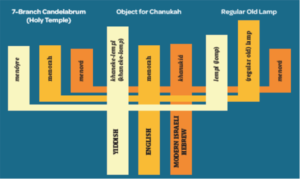 You Say Menoyre, I Say Menorah: A menorah—or menoyre, in Yiddish pronunciation—is not a Hannukah candelabrum. Not in Yiddish, at least. Nor in modern Israeli Hebrew, where the word can mean a basic electric lamp, for instance, or a kerosene lamp, or it could be as elaborate and high-end as a Tiffany. In Yiddish, menoyre is the term for the biblical seven-branched candelabrum originally housed in the Holy Temple—or its likeness, as is often found decoratively in synagogues or as the emblem of the State of Israel. In any event, there is no narrow association in modern Yiddish or Hebrew usage with this being a Chanukah object. How, then, did the word come to be associated with the holder of the Hannukah candles? The answer might have something to do not with Yiddish or Hebrew, but with the Sephardic language of Ladino. Read more: https://www.yiddishbookcenter.org/language-literature-culture/pakn-treger/chanukah-oy-khaneke
You Say Menoyre, I Say Menorah: A menorah—or menoyre, in Yiddish pronunciation—is not a Hannukah candelabrum. Not in Yiddish, at least. Nor in modern Israeli Hebrew, where the word can mean a basic electric lamp, for instance, or a kerosene lamp, or it could be as elaborate and high-end as a Tiffany. In Yiddish, menoyre is the term for the biblical seven-branched candelabrum originally housed in the Holy Temple—or its likeness, as is often found decoratively in synagogues or as the emblem of the State of Israel. In any event, there is no narrow association in modern Yiddish or Hebrew usage with this being a Chanukah object. How, then, did the word come to be associated with the holder of the Hannukah candles? The answer might have something to do not with Yiddish or Hebrew, but with the Sephardic language of Ladino. Read more: https://www.yiddishbookcenter.org/language-literature-culture/pakn-treger/chanukah-oy-khaneke
Search Yiddish Book Center Collections on Your Own: To search our site, go to www.yiddishbookcenter.org/ and click the magnifying glass in the upper right-hand corner. Place your cursor where it says “Search” on the left, and type in any term you’re looking for—a word, phrase, person, place, or subject. In a matter of seconds our “search engine” will look through millions of pages and give you a list of every item—book, tape, video, or more—that meets your criteria. Click on an item that interests you and plutsem, just like that, the full content will appear on your screen, free of charge.
December 2021
“Feygl in der luftn” by Shemuel Tsesler (Samuel Chessler): Feygl in der luftn is a treasure chest for Yiddish teachers—a collection of games and stories for children from a Yiddish shule in Tucman, Argentina in 1939, written by Samuel Chessler, who had only recently immigrated to Argentina from near Bialystok. The poems are full of vibrant images and dramatic stories, and circle games—rhymes with actions that Yiddish students can recite and act out in sing-song voices, helping them to playfully internalize complicated grammatical forms and a broad and colorful vocabulary while reliving the silliness of early childhood. Read more: https://ia600903.us.archive.org/10/items/nybc209650/nybc209650.pdf
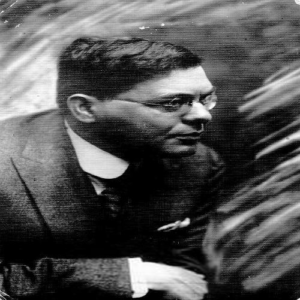
“In Which I Hate It and Can’t Stand It and Don’t Want to and Have No Patience at All” Der Tunkeler monologue, translated by Ri Turner: “I don’t really feel like dealing with literary criticism or with critics themselves. To hell with critics, anyway! I don’t want to read the reports from the League of Nations about the Polish-Lithuanian negotiations—so sue me! I’m too lazy to slice open the pages of the newly arrived Literary Pages, aside from the listings at the end, which I’ll skim through in case one of them mentions me.” Read more: https://www.yiddishbookcenter.org/pakn-treger-translation-issue-2016/which-i-hate-it-and-can-t-stand-it-and-don-t-want-and-have-no
Maeera Schreiber’s Resource Kit on Emma Lazarus’ “The New Colossus:” This kit draws connections within Jewish history and culture and also outside of it—this is a compact poem with an enormous cultural impact and one that many people are familiar with but have not taken the time to unpack and consider as a work of poetry rather than a cultural symbol. This kit gives teachers room to do all of this work. Introduction and resource kit: http://teachgreatjewishbooks.org/resource-kits/emma-lazaruss-new-colossus#resources
Der boym fun lebn: Chava Rosenfarb
November 1, 2021
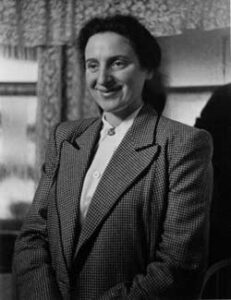 If you were to visit the hometowns of some of the major postwar Yiddish writers, where would you go? New York and Tel Aviv, certainly. Probably also Montreal, Mexico City, and Buenos Aires. But how about Lethbridge, Alberta? While the small Canadian city might not seem like a top destination on such a pilgrimage, it would be a necessary stop. That’s where Chava Rosenfarb, one of the twentieth century’s major Yiddish novelists, eventually made her home and where her daughter and translator, Goldie Morgentaler, still lives. Rosenfarb is best known for her three-volume masterpiece Der boym fun lebn (The Tree of Life), along with several other novels and volumes of stories, poetry, and drama. At the Yiddish Book Center we’ve always been big Rosenfarb fans; here’s some of what we’ve got. There’s no better place to start with Rosenfarb than the works themselves, but you’ll also probably want to check out this talk that Rosenfarb gave in 2004 at Montreal’s Jewish Public Library. Unlike some of Rosenfarb’s previous lectures, this one is in English: https://www.yiddishbookcenter.org/collections/archival-recordings/frances-brandt/fbr-1827_5822/my-life-yiddish-writer-chava-rosenfarb
If you were to visit the hometowns of some of the major postwar Yiddish writers, where would you go? New York and Tel Aviv, certainly. Probably also Montreal, Mexico City, and Buenos Aires. But how about Lethbridge, Alberta? While the small Canadian city might not seem like a top destination on such a pilgrimage, it would be a necessary stop. That’s where Chava Rosenfarb, one of the twentieth century’s major Yiddish novelists, eventually made her home and where her daughter and translator, Goldie Morgentaler, still lives. Rosenfarb is best known for her three-volume masterpiece Der boym fun lebn (The Tree of Life), along with several other novels and volumes of stories, poetry, and drama. At the Yiddish Book Center we’ve always been big Rosenfarb fans; here’s some of what we’ve got. There’s no better place to start with Rosenfarb than the works themselves, but you’ll also probably want to check out this talk that Rosenfarb gave in 2004 at Montreal’s Jewish Public Library. Unlike some of Rosenfarb’s previous lectures, this one is in English: https://www.yiddishbookcenter.org/collections/archival-recordings/frances-brandt/fbr-1827_5822/my-life-yiddish-writer-chava-rosenfarb
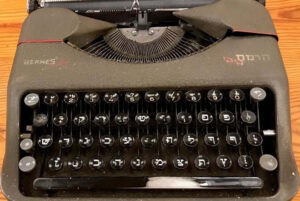 The collections at the Yiddish Book Center are, as our name suggests, mostly books. But every so often we receive other objects as well, which we are happy to store, safeguard, and display. One of these was Rosenfarb’s Hermes Baby typewriter. Measuring just one foot square and 3.5 inches tall, this 1951 Hebrew model is, as Sophia Shoulson writes, “diminutive, compact, and adorable.”
The collections at the Yiddish Book Center are, as our name suggests, mostly books. But every so often we receive other objects as well, which we are happy to store, safeguard, and display. One of these was Rosenfarb’s Hermes Baby typewriter. Measuring just one foot square and 3.5 inches tall, this 1951 Hebrew model is, as Sophia Shoulson writes, “diminutive, compact, and adorable.”
Es Iz a Dybbuk: Yiddish Film
October 1, 2021
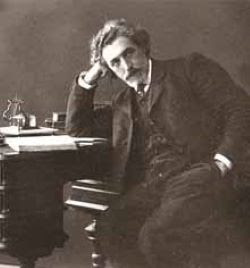 While there are still occasional films made in, or featuring, Yiddish, there was once an entire Yiddish film industry. In the first few decades of the twentieth century approximately 130 full-length Yiddish movies were made, along with a few dozen shorts. Of these dozens of films one stands out: The Dybbuk, based on the play by S. An-sky. Made in Poland and released in 1937, the movie still holds up and has helped An-sky’s play retain its position as one of the best-known Yiddish artworks. Join us as we take a deep dive into the world of The Dybbuk. Excuse us if we become a bit, er, possessed. Who was S. An-sky, the author of The Dybbuk? Born Shloyme-Zanvl Rappoport, An-sky was also an ethnographer and a keen observer of Jewish life in the Russian Pale of Settlement. His ethnographic expeditions in the years leading up to World War I gave us priceless photographs, musical recordings, and information about that soon-to-vanish world. In this lecture Professor Gabriella Safran of Stanford University, author of Wandering Soul: The Dybbuk’s Creator, S. An-sky, leads us through an exploration of this important writer and the turbulent times in which he lived: https://archive.org/details/nybc-online-course-lecture-series-02?utm_source=weeklyreader&utm_medium=email&utm_campaign=weeklyreader
While there are still occasional films made in, or featuring, Yiddish, there was once an entire Yiddish film industry. In the first few decades of the twentieth century approximately 130 full-length Yiddish movies were made, along with a few dozen shorts. Of these dozens of films one stands out: The Dybbuk, based on the play by S. An-sky. Made in Poland and released in 1937, the movie still holds up and has helped An-sky’s play retain its position as one of the best-known Yiddish artworks. Join us as we take a deep dive into the world of The Dybbuk. Excuse us if we become a bit, er, possessed. Who was S. An-sky, the author of The Dybbuk? Born Shloyme-Zanvl Rappoport, An-sky was also an ethnographer and a keen observer of Jewish life in the Russian Pale of Settlement. His ethnographic expeditions in the years leading up to World War I gave us priceless photographs, musical recordings, and information about that soon-to-vanish world. In this lecture Professor Gabriella Safran of Stanford University, author of Wandering Soul: The Dybbuk’s Creator, S. An-sky, leads us through an exploration of this important writer and the turbulent times in which he lived: https://archive.org/details/nybc-online-course-lecture-series-02?utm_source=weeklyreader&utm_medium=email&utm_campaign=weeklyreader
Dos Yam-Medele: Yiddish Little Mermaid
September 1, 2021
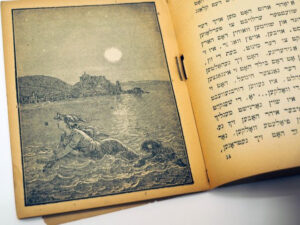 The stories of Hans Christian Anderson, originally written in Danish and translated into more than one hundred languages, are among the world’s most popular and recognizable fairly tales. “The Little Mermaid,” in particular, has been imagined and reimagined, including in Yiddish as “Dos yam-meydele.” Does it include a singing lobster? You’ll have to read it to find out: https://www.yiddishbookcenter.org/language-literature-culture/vault/dos-yam-meydele-little-mermaid?utm_
The stories of Hans Christian Anderson, originally written in Danish and translated into more than one hundred languages, are among the world’s most popular and recognizable fairly tales. “The Little Mermaid,” in particular, has been imagined and reimagined, including in Yiddish as “Dos yam-meydele.” Does it include a singing lobster? You’ll have to read it to find out: https://www.yiddishbookcenter.org/language-literature-culture/vault/dos-yam-meydele-little-mermaid?utm_
1001 Nights
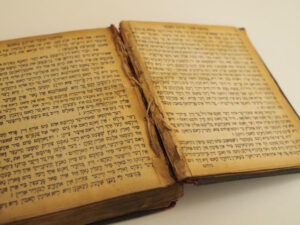 Toyzind und eyne nakht is a retelling of the famous Arabic collection One Thousand and One Nights. Such works were so popular in part because they made pieces of literature accessible to Jews who couldn’t read them in their original language—and likely because they were written in the same style as Jewish oral histories and folklore. Read more at: https://www.yiddishbookcenter.org/language-literature-culture/vault/toysnd-un-eyne-nakht-one-thousand-and-one-nights?utm_
Toyzind und eyne nakht is a retelling of the famous Arabic collection One Thousand and One Nights. Such works were so popular in part because they made pieces of literature accessible to Jews who couldn’t read them in their original language—and likely because they were written in the same style as Jewish oral histories and folklore. Read more at: https://www.yiddishbookcenter.org/language-literature-culture/vault/toysnd-un-eyne-nakht-one-thousand-and-one-nights?utm_
August 2, 2021
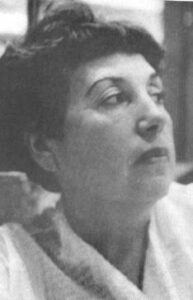
Poetry
Rajzel Żychlińsky (born July 27, 1910, pictured here ) was a Polish-born Yiddish poet who had a successful career in Warsaw before the Holocaust and an international one afterward. Those who know her work consider her one of the twentieth century’s best Yiddish poets, and she published some seven collections during her lifetime. In addition to being a writer she was also a literary scholar, as attested to by this rare lecture on Faust and Peer Gynt, which she gave in Yiddish at Montreal’s Jewish Public Library in 1963.
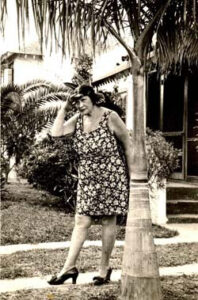 Fiction
Fiction
One of the best popular Yiddish fiction writers was Miriam Karpilove, a prolific author of serialized novels, short stories, plays, and sketches. Yudis, one of her first published works, is an epistolary novel that follows the protagonist, Judith, and her tumultuous romance with Joseph, a Jewish intellectual from a well-off family. Read an excerpt from Yudis, translated into English by Jessica Kirzane.
Yidstock!
July 2, 2021
From Lorna Holmes
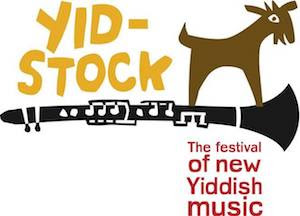
July 11 is Yidstock!
Yidstock: The Festival of New Yiddish Music, a pre-recorded, 75-minute program featuring a dozen musicians from around the world. Featuring Eleanor Reissa, Lorin Sklamberg, Frank London, Daniel Kahn, and more, performing a broad and eclectic repertoire of social justice songs recorded exclusively for Yidstock and drawn from Yiddish music and literature. These include labor anthems, protest songs, humanitarian odes, songs of struggle, and songs based in Yiddish poetry.
Kinder Yorn
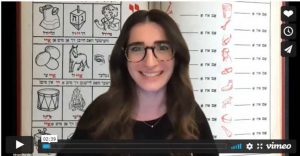 Childhood—kinder yorn—is a constant theme in Yiddish literature. And childhood education, in the form of the traditional kheyder, especially so. Whether that meant a tyrannical teacher with a stick or a strap, or something more enlightened, Yiddish writers were often inclined to cast a backwards gaze to their earliest educational experiences. The Yiddish Book Center is a far cry from a shtetl schoolroom, but as our summer programs begin we can’t help but look back on the rich history of Jewish education, even as we carry it forward. The idea of kheyder takes us back to the nineteenth century, or earlier, but it wasn’t until the mid-twentieth century that Yiddish primers and other educational materials really flourished. These books and notebooks have much to tell us—but so does what their users left behind: doodles, addresses, jokes, and other marginalia that provide a glimpse into the inner world of schoolchildren in a unique educational system. Miriam Borden is a collector of these archival objects and recently won the 2020 Honey & Wax Book Collecting Prize for her trove of schoolbooks, flashcards, and more. In this presentation, she shares highlights of this collection and the stories behind them.
Childhood—kinder yorn—is a constant theme in Yiddish literature. And childhood education, in the form of the traditional kheyder, especially so. Whether that meant a tyrannical teacher with a stick or a strap, or something more enlightened, Yiddish writers were often inclined to cast a backwards gaze to their earliest educational experiences. The Yiddish Book Center is a far cry from a shtetl schoolroom, but as our summer programs begin we can’t help but look back on the rich history of Jewish education, even as we carry it forward. The idea of kheyder takes us back to the nineteenth century, or earlier, but it wasn’t until the mid-twentieth century that Yiddish primers and other educational materials really flourished. These books and notebooks have much to tell us—but so does what their users left behind: doodles, addresses, jokes, and other marginalia that provide a glimpse into the inner world of schoolchildren in a unique educational system. Miriam Borden is a collector of these archival objects and recently won the 2020 Honey & Wax Book Collecting Prize for her trove of schoolbooks, flashcards, and more. In this presentation, she shares highlights of this collection and the stories behind them.
Fathers in Yiddish Literature
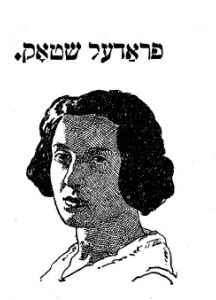 Yiddish might be affectionately known as mame loshn—mother tongue—but the language has a special place for fathers. Whether they appear as towering authority figures or humble, well-meaning schlemiels, Yiddish literature and culture is replete with all kinds of fathers—no single type will do. The stereotype of Jewish parents as protective and overbearing may seem like it belongs to Philip Roth and Seinfeld, but it goes back further than that. Fradel Shtock, an immigrant from the Austro-Hungarian Empire, was a modernist poet and short-story writer who made her mark on Yiddish literary circles in the early decades of the twentieth century. In this story, “The First Patient” (translated for Pakn Treger by Jordan Finkin and Allison Schachter), she describes a young dentist trying to deal with his meddling parents, who think they know what’s best for him and his fledgling practice.
Yiddish might be affectionately known as mame loshn—mother tongue—but the language has a special place for fathers. Whether they appear as towering authority figures or humble, well-meaning schlemiels, Yiddish literature and culture is replete with all kinds of fathers—no single type will do. The stereotype of Jewish parents as protective and overbearing may seem like it belongs to Philip Roth and Seinfeld, but it goes back further than that. Fradel Shtock, an immigrant from the Austro-Hungarian Empire, was a modernist poet and short-story writer who made her mark on Yiddish literary circles in the early decades of the twentieth century. In this story, “The First Patient” (translated for Pakn Treger by Jordan Finkin and Allison Schachter), she describes a young dentist trying to deal with his meddling parents, who think they know what’s best for him and his fledgling practice.
Di Mishpokhe Karnovski (The Family Carnovsky)
J. Singer was Isaac Bashevis Singer’s older brother—and he was also a far more accomplished novelist. The Family Carnovsky (1943) offers a sprawling narrative about anti-Semitism and Jewish resilience as seen through the prism of a single family. The audio recording is available in Yiddish.
“Go Be a Prophet!”
February 8, 2021
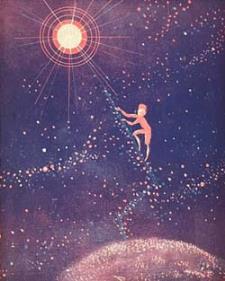 There’s a Yiddish expression that says, “Gey zay a novi—Go be a prophet!” That’s exactly what the anonymous author of “The World in the Year 2058” tried to do back in 1958, when this curious Yiddish text was written. Not unlike the prognostications of Jules Verne (whom we’ll encounter below), the author’s prescient predictions included video phones, solar power, collision avoidance systems for cars, trackless trains, “airplanes that will fly at a speed of 1,000 miles an hour,” and self-heating and cooling clothing made of artificial fibers since “already silk, wool and cotton are hardly used.” Read more about “The World in the Year 2058” by Anonymous, Translated by Patrick Casiano, and other books at the Yiddish Book Center.
There’s a Yiddish expression that says, “Gey zay a novi—Go be a prophet!” That’s exactly what the anonymous author of “The World in the Year 2058” tried to do back in 1958, when this curious Yiddish text was written. Not unlike the prognostications of Jules Verne (whom we’ll encounter below), the author’s prescient predictions included video phones, solar power, collision avoidance systems for cars, trackless trains, “airplanes that will fly at a speed of 1,000 miles an hour,” and self-heating and cooling clothing made of artificial fibers since “already silk, wool and cotton are hardly used.” Read more about “The World in the Year 2058” by Anonymous, Translated by Patrick Casiano, and other books at the Yiddish Book Center.
“Is Isaac Bashevis Singer a Yiddish Writer?”
January 9, 2021
This question is not as preposterous as it sounds. As beloved as he was by English readers, Singer was widely reviled by many in the Yiddish world, who denounced him as superstitious, otherworldly, pornographic, misogynistic, and out of step with a fundamental tenet of modern Yiddish literature: that it was possible to live a moral life outside the constraints of Jewish law. Twenty-nine years after Singer’s passing, Aaron Lansky revisits the debate and asks whether Singer has finally been farkashert—redeemed—by the passage of time.
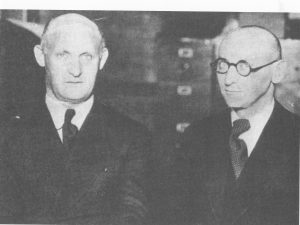
Israel Joszua Singer (left) and Isaac Bashevis Singer (right)
Read the article by Aaron Lansky:
Yiddish Book Center
November 29, 2020
News and Upcoming Programs
The Drowning Shore: A Cantata in Yiddish and Scottish
London-based singer Clara Kanter, the great-great-granddaughter of Yiddish writer Sholem Asch, and composer Alastair White visit with The Shmooze to talk about The Drowning Shore, their newly released cantata, which threads together Asch’s classic 1907 play God of Vengeance with an original Scots-English text. The piece, a 14-minute video monodrama scored for ‘a mezzo-soprano in a screen,’ is written and composed by Alastair and performed by Clara. The two collaborators talk with us about how they came to make this stunning work. Podcast avalable at: https://www.yiddishbookcenter.org/language-literature-culture/the-shmooze/280-drowning-shore-cantata-yiddish-and-scottish
Nov 24, 2020 | Episode 280 | 33 Min | Guests: Clara Kanter Alastair White | Host: Lisa Newman

Yiddish Book Center
1021 West Street
Amherst, MA 01002
413.256.4900
info@yiddishbookcenter.org
The Yiddish Book Center
November 3, 2020
By Sid Goldstein
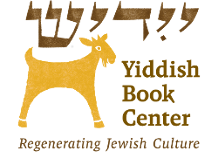
The Yiddish Book Center, founded in 1980 by Aron Lansky, is celebrating its fortieth anniversary. The Center was created to preserve Yiddish literature and Yiddish culture. The Center undertakes programs designed to foster a deeper understanding of how Yiddish remains relevant in the context of modern Jewish culture. To this end, the Center has revitalized thousands of pieces of Yiddish literature that were thought to be lost. Their staff is continually searching the globe for Yiddish literature that existed and thrived but is rare and difficult to find. In the course of his studies, Lansky realized that untold numbers of irreplaceable Yiddish books—the primary, tangible legacy of a thousand years of Jewish life in Eastern Europe—were being discarded by American-born Jews unable to read the language of their Yiddish-speaking parents and grandparents. So he organized a nationwide network of zamlers (volunteer book collectors) and launched a concerted campaign to save the world’s remaining Yiddish books before it was too late. When the Center began, experts estimated that 70,000 Yiddish books were still extant and recoverable. The Center’s young staff surpassed that number in six months and went on to recover more than a million volumes—some lovingly handed to them by their original owners, others rescued at the last minute from demolition sites and dumpsters. They have found books in the United States, Canada, Mexico, Cuba, Venezuela, Chile, Uruguay, Argentina, England, France, South Africa, Australia, and other countries around the world. And they continue to collect thousands of additional volumes each year.
Since 2007, the Yiddish Book Center has made more than 12,000 titles available online in the Steven Spielberg Digital Yiddish Library. This comprehensive collection includes works of fiction, memoirs, poetry, plays, short stories, science manuals, cookbooks, primers, and more. These are works by the most renowned Yiddish authors and lesser-known writers alike. To date, those titles have been downloaded an astonishing 1.6 million times. The Center also sponsors podcasts called The Shmooze that run weekly on their website. A typical example was last week. On a call all the way from Scotland, Morgan Holleb and Joe Isaac talk about how they came to co-found Glasgow’s new Peacock Café—a Yiddish-speaking kosher café operated by Jewish self-described ‘schnorrers’ where customers will “pay what they can.” Every year the Yiddish Book Center undertakes a themed project. This year’s theme focuses on Jewish immigration and the ways in which the encounter with Yiddish culture has shaped Jewish life in America over the past 150 years. In celebration of this theme, the Center spotlighting a collection of short interview excerpts from the Wexler Oral History Project about American Jewish farming communities in the US, a slideshow with iconic images from New York’s Yiddish theater, and a “From the Vault” piece by Eitan Kensky about some of the more “colorful” guidebooks in our collection written for Jewish immigrants to the United States. All of these pieces are available for members to download, read and enjoy. Becoming a member of the Yiddish Book Center is not difficult. Go to yiddishbookcenter.org and click on “Join & Support” on the top right side of the homepage. Membership is $54.00 per year. Besides having access to all the digital library materials, as well as the project archives, you will also receive a copy of their beautiful quarterly newsletter Kvel (Delight). The Yiddish Book Center continually strives to make more and more Yiddish materials available to the Jewish public. Even during the pandemic, their researchers continue the task of finding and revitalizing pieces of Yiddish literature so that we, our children and our grandchildren can maintain a connection to the places from where we came and the unique culture that we created.
